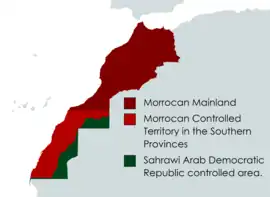Southern Provinces

The Southern Provinces (Arabic: الأقاليم الجنوبية, romanized: Al-Aqalim al-Janubiyah, French: Provinces du Sud) or Moroccan Sahara (Arabic: الصحراء المغربية, romanized: Assahra al-Maghribiya, French: Sahara marocain) are the terms utilized by the Moroccan government to refer to the disputed territory of Western Sahara. These designations encompass the entirety of Western Sahara, which spans three of Morocco's 12 top-level administrative regions. The term "Southern Provinces" frequently appears in Moroccan state television (e.g., weather forecasts, news maps, and official statements).
Background
Western Sahara was formerly a Spanish colony known as the Spanish Sahara. In the 1970s, Spain faced mounting pressure from Morocco to relinquish the territory, culminating in the Green March, a large-scale demonstration organized by the Moroccan government on November 6, 1975. The Green March was orchestrated to compel Spain to transfer Western Sahara to Morocco. The Madrid Accords, ratified just 12 days after the Green March, stipulated that Spain would exit Western Sahara by February 28, 1976 at the latest. Subsequently, Morocco and Mauritania signed the Western Sahara partition agreement on April 14, 1976. This agreement led to Morocco assuming control over Saguia el-Hamra and the northern portion of Río de Oro, while Mauritania took charge of the remaining part of Río de Oro, renaming it as Tiris al-Gharbiyya.
A locally based Sahrawi national liberation movement, known as the Polisario Front, initiated a guerrilla war on February 27, 1976, with significant financial and logistical support from Algeria and Libya. Their goal was to achieve independence for the territory under the banner of the "Sahrawi Arab Democratic Republic" (SADR). Following clashes with Polisario forces (SPLA) and strained relations with Algeria, Mauritania withdrew in 1979, relinquishing its claim on Western Sahara to avoid further complications with the Sahrawi Republic, Algeria, and Morocco. Capitalizing on the opportunity, Morocco extended control over the remaining part of Río de Oro, which had previously been recognized as Mauritanian.
Since a United Nations-brokered ceasefire agreement in 1991, approximately two-thirds of the territory has been administered by Morocco, encompassing most of the coastline. This area is separated from the eastern third controlled by the Polisario Front by the Moroccan Western Sahara Wall or "the Berm," referred to by the Polisario Front as the "Free Zone."
The ceasefire line corresponds to the route of the Berm, with both sides asserting sovereignty over the entire territory of Western Sahara. The Sahrawi Arab Democratic Republic has received recognition from 84 nations and is a full member of the African Union, though not of the UN. The Arab League implicitly recognizes Moroccan territorial integrity, albeit with significant reservations from Algeria and Syria.
Overview

The Moroccan government exercises control over approximately two-thirds of Western Sahara (the portion west of the Berm), while the remaining part constitutes the Polisario Front-controlled Sahrawi Arab Democratic Republic.
Morocco treats the two-thirds of Western Sahara under its control as integral Moroccan territory. The government implements various economic and social development initiatives, incorporating these "Southern Provinces" into the national budget for government funding, national sports competitions, educational programs, and national parliamentary elections. The total population of Western Sahara is around 576,000.[1] Coastal areas are utilized for fishing, and land areas are exploited for phosphate mining by both government and private entities.
In terms of administration, Morocco divided its controlled territory into administrative units (wilayas). Flags and coats of arms were established for the three wilayas of Boujdour,[2] Smara, and Laayoune.[3] In 1983, further changes occurred, resulting in the establishment of four wilayas, with the addition of Dakhla.[4] In 1990, Wadi al-Dhahab (Río de Oro) was also incorporated.
As of 2022, the Southern Provinces are organized into three regions: Guelmim-Oued Noun in the north, Laâyoune-Sakia El Hamra in the center, and Dakhla-Oued Ed-Dahab in the south. These regions are further subdivided into ten provinces. The regions of Guelmim-Oued Noun and Laâyoune-Sakia El Hamra encompass parts of the Western Saharan territory as well as undisputed Moroccan territory to the north.
Morocco has designated a dedicated satellite TV channel for the "Southern Provinces," known as Laayoun TV.
Moroccan settlers
Following the 1975 Green March, the Moroccan state initiated settlement programs that encouraged numerous Moroccans to relocate to the Moroccan-administered portion of Western Sahara (accounting for 80% of the territory). By 2015, it was estimated that Moroccan settlers constituted at least two-thirds of the 500,000 inhabitants.[5] In addition to offering a right of return for the Sahrawi refugees, the Sahrawi government in exile expressed a willingness to grant Sahrawi citizenship to Moroccan settlers and their descendants in a prospective independent state.[6][7]
References
- United Nations. "World Population Prospects 2019". population.un.org. Retrieved October 13, 2022.
- "Boujdour province, Morocco". crwflags.com. Retrieved March 20, 2007.
- "Laayoune province, Morocco". crwflags.com. Retrieved March 20, 2007.
- "Dakhla (Oued Eddahab-Lagouira) Province, Morocco". crwflags.com. Retrieved March 20, 2007.
- "Western Sahara's stranded refugees consider renewal of Morocco conflict". the Guardian. January 6, 2015.
- "South African Institute for Security Studies" (PDF). Archived from the original (PDF) on July 26, 2018. Retrieved February 11, 2017.
- Canadian Government Website report on SADR offer of citizenship to Moroccan settlers